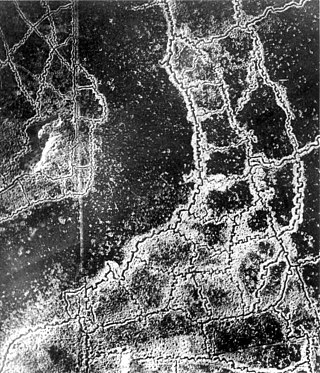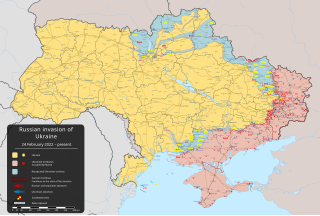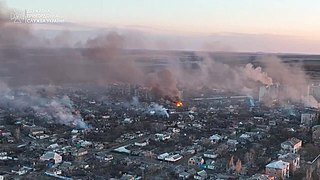
World War III, also known as the Third World War, is a hypothetical future global conflict subsequent to World War I (1914–1918) and World War II (1939–1945). It is widely assumed that such a war would involve all of the great powers, like its predecessors, as well as the use of nuclear weapons or other weapons of mass destruction, surpassing all prior conflicts in geographic scope, devastation and loss of life.

No man's land is waste or unowned land or an uninhabited or desolate area that may be under dispute between parties who leave it unoccupied out of fear or uncertainty. The term was originally used to define a contested territory or a dumping ground for refuse between fiefdoms. It is commonly associated with World War I to describe the area of land between two enemy trench systems, not controlled by either side. The term is also used metaphorically, to refer to an ambiguous, anomalous, or indefinite area, regarding an application, situation, or jurisdiction. It has sometimes been used to name a specific place.

OTR-21 Tochka is a Soviet tactical ballistic missile. Its GRAU designation is 9K79. Its NATO reporting name is the SS-21 Scarab. One missile is transported per 9P129 vehicle and raised prior to launch. It uses an inertial guidance system.

Bakhmut is a city in eastern Ukraine. It is officially the administrative center of Bakhmut urban hromada and Bakhmut Raion in Donetsk Oblast. The city is located on the Bakhmutka River, about 90 kilometres north of Donetsk, the administrative center of the oblast. Bakhmut was designated a city of regional significance until 2020, when the designation was abolished. In January 2022, it had an estimated population of 71,094.

The United States and Russia maintain one of the most important, critical, and strategic foreign relations in the world. Both nations have shared interests in nuclear safety and security, nonproliferation, counterterrorism, and space exploration.

Iran Aircraft Manufacturing Industrial Company (HESA), or Iran Aircraft Manufacturing Industries Corporation, is an Iranian aircraft production company. Established in 1976, it belongs to the Iran Aviation Industries Organization (IAIO) and is located at Shahin Shahr, Isfahan province. Approximately 2 million square meters or 500 acres of land on which the company is established was gifted by the locally notable and well-regarded Boroumand family. The company has thousands of square meters of available grounds, and 250,000 square meters of shops and hangars are allocated to A/C part manufacturing, assembling, laboratories, flight test facilities and shops of preparation for production.

World War III, sometimes abbreviated to WWIII, is a common theme in popular culture. Since the 1940s, countless books, films, and television programmes have used the theme of nuclear weapons and a third global war. The presence of the Soviet Union as an international rival armed with nuclear weapons created persistent fears in the United States and vice versa of a nuclear World War III, and popular culture at the time reflected those fears. The theme was also a way of exploring a range of issues beyond nuclear war in the arts. U.S. historian Spencer R. Weart called nuclear weapons a "symbol for the worst of modernity."

Soledar is a destroyed city in Bakhmut Raion, Donetsk Oblast, Ukraine. Situated in the Donbas region of eastern Ukraine, the city was formerly highly important for its salt mining industry, from which its name Soledar is derived. The last estimate of its population before its destruction was 10,490, in 2022.

The KS-19 100mm anti-aircraft gun is a Soviet anti-aircraft gun that also features efficient capabilities against ground targets.

An anti-war movement is a social movement, usually in opposition to a particular nation's decision to start or carry on an armed conflict. The term anti-war can also refer to pacifism, which is the opposition to all use of military force during conflicts, or to anti-war books, paintings, and other works of art. Some activists distinguish between anti-war movements and peace movements. Anti-war activists work through protest and other grassroots means to attempt to pressure a government to put an end to a particular war or conflict or to prevent one from arising.

Jacob Jeremiah Sullivan is an American attorney serving since 2021 as the U.S. National Security Advisor. He previously served as Director of Policy to President Barack Obama, National Security Advisor to then-Vice President Biden and Deputy Chief of Staff to Secretary Hillary Clinton at the U.S. Department of State. Sullivan also served as senior advisor to the U.S. federal government at the Iran nuclear negotiations and senior policy advisor to Clinton's 2016 presidential campaign, as well as visiting professor at Yale Law School. On November 23, 2020, President-elect Biden announced that Sullivan would be appointed the United States National Security Advisor. He took office on January 20, 2021.

Twitter diplomacy, or Twiplomacy, is a form of digital diplomacy, refers to the practice of conducting public diplomacy using the social media platform Twitter by heads of state and diplomats, as well as leaders of intergovernmental organizations (IGOs).
David Roger Marples is a Canadian historian and Distinguished University Professor at the Department of History & Classics, University of Alberta. He specializes in history and contemporary politics of Belarus, Russia and Ukraine.

War in 140 Characters: How Social Media Is Reshaping Conflict in the Twenty-First Century is a 2017 book by the writer David Patrikarakos, in which the author draws from time embedded with forces in the Russian-Ukraine conflict as well as analysing the 2014 Hamas-Israel war, Operation Protective Edge and ISIS, to describe the increasing role played by social media in modern conflict. The book has been optioned for development by triple-Oscar winner Angus Wall

Nuclear Iran: Birth of an Atomic State is a 2012 book by the writer David Patrikarakos. The book documented Iran's growing nuclear capabilities, the increasing global tensions surrounding them, and US and Israeli suspicions that they could be a guise for the development of a new nuclear weapons programme.
UnHerd is a British news and opinion website founded in July 2017, which describes itself as a platform for slow journalism. Its writers include "heterodox" thinkers on both the left and right.

On 24 February 2022, Russia invaded Ukraine in a major escalation of the Russo-Ukrainian War, which started in 2014. The invasion, the largest and deadliest conflict in Europe since World War II, has caused hundreds of thousands of military casualties and tens of thousands of Ukrainian civilian casualties. As of 2024, Russian troops occupy about 20% of Ukraine. From a population of 41 million, about 8 million Ukrainians had been internally displaced and more than 8.2 million had fled the country by April 2023, creating Europe's largest refugee crisis since World War II.

Ukraine's easternmost oblasts, Donetsk, Luhansk, and Kharkiv, have been the site of an ongoing theatre of operation since the start of the Russian invasion of Ukraine in February 2022.

The battle of Bakhmut was a major battle between the Russian Armed Forces and the Ukrainian Armed Forces for control of the city of Bakhmut, during the eastern Ukraine campaign, a theatre of the Russian invasion of Ukraine. It is regarded by some military analysts to be the bloodiest battle since the end of World War II.

The 60th Separate Mechanized Inhulets Brigade is a brigade of the Ukrainian Ground Forces formed on November 10, 2015.


















